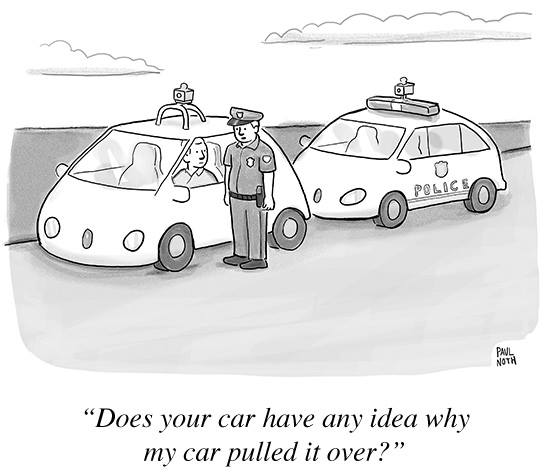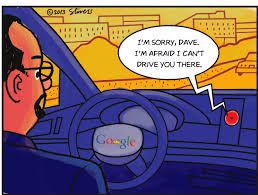 Journalists covering the birth of the self-driving car industry are being kept very busy, and sometimes they must worry if they can keep up with all the new announcements. They haven’t even had time to pause for long enough to give the industry a proper name: “self-driving cars” is too long and too ugly. By way of giving them a helping hand, I’d like to suggest “auto-cars”. That was the name for the horseless carriage adopted by The Times of London newspaper in the late 19th century. Linguistic purists objected that it mixed Greek (auto) with Latin (car), so if anyone still cares about that sort of thing they might prefer to shorten it to “auto”.
Journalists covering the birth of the self-driving car industry are being kept very busy, and sometimes they must worry if they can keep up with all the new announcements. They haven’t even had time to pause for long enough to give the industry a proper name: “self-driving cars” is too long and too ugly. By way of giving them a helping hand, I’d like to suggest “auto-cars”. That was the name for the horseless carriage adopted by The Times of London newspaper in the late 19th century. Linguistic purists objected that it mixed Greek (auto) with Latin (car), so if anyone still cares about that sort of thing they might prefer to shorten it to “auto”.
In the last couple of weeks alone we have seen a series of significant announcements. Uber announced live trials of self-driving taxis in Pittsburgh, thereby enhancing the Steel City’s claims to rival Silicon Valley as the spiritual home of the auto-car. Uber’s legions of self-employed drivers mostly displayed a sort of battle-scarred weary acceptance of their fate as temporary stand-ins for the machines, although Uber’s CEO Travis Kalanick made a brave (some would say risible) attempt to argue that the move to auto-cars will create more jobs than it destroys because machines will not be able to handle all the routes and journeys.
Also in the last fortnight, Helsinki revealed that it is joining a small list of cities trialling driverless buses. Trikala in Greece was the first European city on the list, back in October 2015. Very sensibly, they are proceeding with caution: the robo-buses will hit top speed at a leisurely 10 miles per hour.
An article published this weeki listed no fewer than 19 car manufacturers, software suppliers and component manufacturers who are committed to having fully automated cars on the road by 2020. Some of them, like Volvo and Tesla, have said they will be ready years before that – if the regulators are.
This raises again the debate about how much automation to offer drivers in the early stages of the auto-car industry. Tesla has been criticised – mostly unfairly – for making its customers complacent about the need to remain vigilant when at the wheel by calling its driver assisting technology Autopilot. When someone is as wildly popular as Elon Musk has (justifiably) become there is bound to be a backlash, and his critics rail against him for putting the safety of Tesla drivers at risk with a “beta” version of the software. Musks’s response has been typically direct and acerbic.
But it is undeniable that humans struggle to pay attention when a machine appears to be doing its job perfectly. Google noticed this when it found the engineers chaperoning its experimental self-driving cars were doing dubious things like turning round to pick up laptops from the back seat while driving along the freeway at 60 miles an hour. Google concluded that self-driving cars should be – at launch – what the US National Highway Traffic Safety Administration designates as L4. This means the car’s artificial intelligence can “perform all safety-critical driving functions and monitor roadway conditions for an entire trip”. Tesla’s Autopilot is currently L2, but the company says it will have L4 available in 2018. (L5 means the car has no steering wheel.)
These developments and announcements are all fascinating in their own right, and they certainly keep the journos busy. Collectively, they show that the ecosystem of self-driving cars is becoming varied, and ever more life-like. Only people who are just not paying attention can now deny that the 2020s will the decade of the auto-car.
But what are we to make of it all? Fundamentally, is it a good thing?

Auto-cars will have several profound impacts on humanity. The most important one is that fewer of us will be killed or maimed by cars. Human drivers currently kill 1.2m people a year on the world’s roads, and we injure a further 20 to 50 million. Globally, road traffic accidents are the leading cause of death for people aged 15 to 29, and they cost middle-income countries around 2% of their GDP, amounting to $100 billion a year. We are sending humans to do a machine’s job, and this slaughter cannot end too soon.
A less dramatic but nevertheless profound result will be that commuters will gain time and lose stress. I suspect this will have a bigger impact than we currently realise. One unexpected consequence may be that people will travel around more, as driving becomes less of a tiring chore and more like sitting in your armchair at home: comfortable, and fully in touch with your screens and digital feeds – including virtual reality. No doubt somebody has already written the science fiction story in which many people no longer have homes, but spend their time as nomads in self-driving RVs, slowly touring the world, scheduling frequent rendez-vous with friends in exotic locations, and always plugged into the network.
More prosaically, because AIs will drive more efficiently and safely than we do, they will make more efficient use of space, especially in our cities. Traffic jams and pollution will ease, and if the car-sharing model promoted by Uber and others takes hold, there could be less need for parking spaces, as cars spend less of their time sitting idly in driveways and garages.
For me, though, the most intriguing impact will be that auto-cars will probably cause the first great wave of unemployment caused by machine intelligence. An estimated 3.5m Americans are employed as truck drivers, and it is the most common profession in a majority of US states. There are also 650,000 bus drivers and 230,000 taxi drivers. (This latter figure seems very low considering how many people now make their living by driving for Uber, Lyft and so on.) By 2030, most of these people will have either found a new profession, or they will have joined the long-term unemployed. It is a huge tranche of the working population for the economy to absorb.
As mainstream economists rightly point out, automation has not caused long-term unemployment in the past. In my new book, The Economic Singularity, I argue that it is different this time, and that we need to monitor and prepare.
i http://read.bi/2buQcuj



